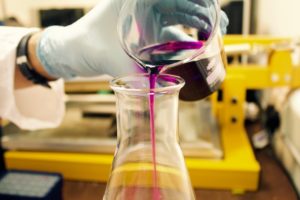Whether you have just moved into a new lab or simply need a reorganisation of your current one, it is very important to maintain a few organisational protocols that will keep your laboratory and team efficient, reliable and safe. By ‘organise’, we simply mean the structure of your lab – what is stored in what cupboard? Where is your safety equipment? What is the state of your working bench(es)? etc. and without efficient structure, your lab can become unsafe and confusing for you and your team.
Here at Benchmark Services, we offer services in lab relocations, that is why we have collected a few useful things to consider when organising your lab and exactly how you can maintain and a clean, safe, organised working environment.
1. Organise each working bench
If you don’t know what a working bench is, it is simply a table, bench or station where an individual’s experiments and data is carried out and collected. Whilst many say a busy bench is a sign of a busy, hard-working scientist, a smartly organised working bench makes you look a lot more professional, less likely to miss or lose anything and is much more time efficient. An organised working bench will keep you fully concentrated on your work as well as keep your documents in a safe, analysed manner.
Furthermore, in order to organise your working bench, you can start by collecting important documents and arranging them into folders, drawers and on surfaces neatly, in a place, you won’t forget or cause damage to them. We would also recommend keeping all small tools such as pipettes and beakers on the side of your dominant hand, furthest away from notebooks and important documents so nothing is spilt during experimentation. Place all stationary in a pencil case or pot, hang your bag and coat way from the experimentation area, and make sure you are aware of the protocol if a substance is spilt or a piece of equipment is broken.
2. Store away all supplies
There is nothing messier than a laboratory with equipment all over the place. It looks incredibly unprofessional and can actually cause your work environment to become quite unsanitary and unsafe. Remove the “un”s of these words and organise your lab to look presentable, sanitary and safe for the team and visitors. As a result of this, store away all supplies that aren’t necessary to be out on the worktops on a permanent basis, such as beakers, chemicals, flasks, tubes, Petri dishes etc. Organise them into trays and boxes to keep them efficiently separated, so the team are able to access all of them behind one door.
3. Ensure chemicals are in a safe spot
Chemicals are probably the most hazardous pieces of equipment not just during lab relocations, but in general! So ensuring they are organised appropriately is actually essential for a safe working environment. If you have just moved in after a lab equipment removal, our best advice would be to first separate chemicals that don’t ‘get along’ with each other, to prevent any minor reactions or major explosions within the lab. Afterwards, simply implement a chemicals cupboard somewhere I.e. a cupboard or two entirely dedicated to the chemicals you have. This should be a spot where they are out of the risk of falling or being knocked in to – the most ideal location would just be a hidden and secure area for your team to easily access.
4. Keep your safety equipment close
Gloves, goggles and coats etc. need to be close to your workstations at all times. When organising your new lab (or reorganising your current one), it may be a good idea to invest in a coat hanger or some sort of system that keeps this protection close, easy to reach and out of the way of chemicals. Protection in the lab is HIGHLY important and required by law in a laboratory because it prevents workers in the environment from getting hazardous substances and equipment in their eyes and on their skin.
5. Invest in some signage
When organising your laboratory, a good idea would be to invest in some (or create your own) signage. Signage not only guides but warns workers and visitors. Because of the dangerous chemicals, substances and equipment around the environment, it’s required by law to have some sort of warning signage around the lab. As well as this, you can take the opportunity to label cupboards and storage to make equipment hunting a lot easier for the team.
When you go through the lab relocations process, it can be particularly exciting getting settled in a new work environment. The best way to brand it and really make it look your own, invest in some signage!
6. Order supplies correctly
How often does your lab accidentally place duplicate orders? How much money is wasted on these scenarios each year? How often do you run out of supplies unexpectedly? Develop an organised strategy or system within the team to prevent duplicate orders, unexpected shortages of supplies and wasted money. These systems can allow you and your team to be able to focus on your hypothesis and only worry about these costly issues when accidents happen.
7. Organise a work schedule
Work schedules are incredibly useful at any type of workplace. It allows the team to understand their shifts and manage their time. This gets more work done in the amount of time the staff have in the week because it’s clearly displayed on a schedule. This maintains a professional amount of organisation within the environment, so we would seriously recommend one.
Lab Relocations Services…
Here at Benchmark Services, we are a dedicated, professional team who offer services in lab relocations, equipment disposal and storage. We want to help you – get in contact with us today for all enquiries or like Benchmark Services’ Facebook Page to keep up to date with us!
Thanks for listening.




Recent Comments